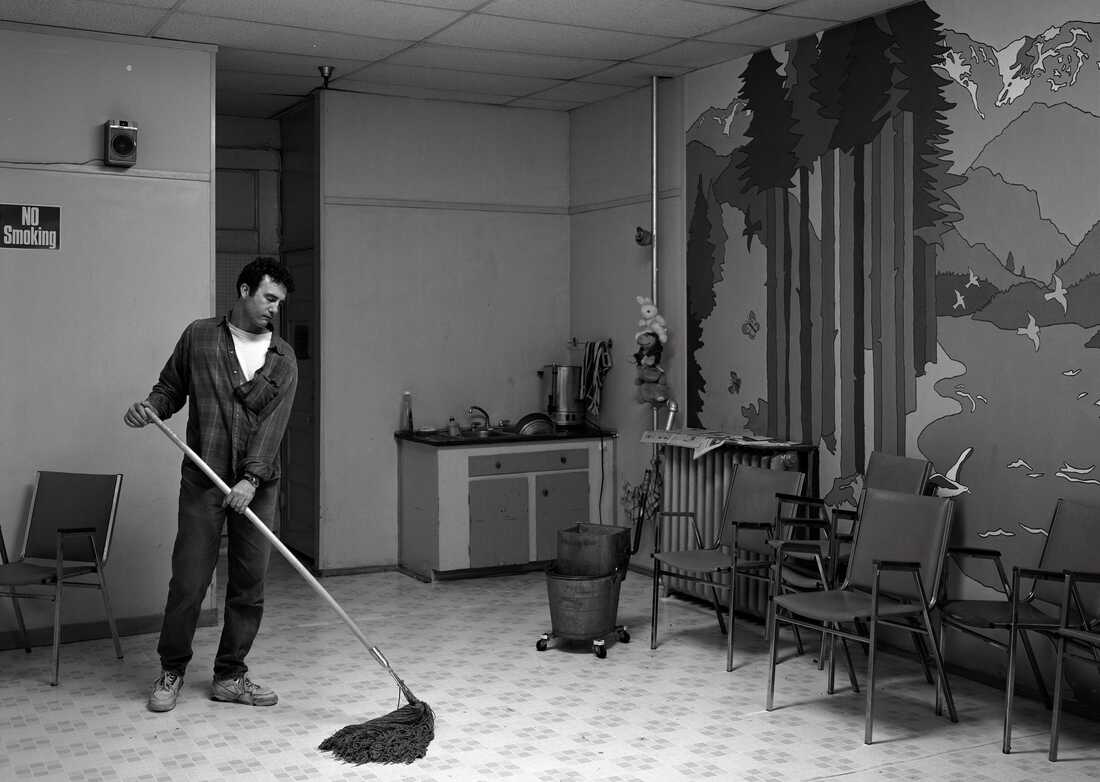Why the photographer Jeff Wall relies on memory — not his camera — to make his art
Canadian photographer Jeff Wall says, "I begin by not photographing." That's right: no snaps, no selfies. He doesn't like the idea — in his words, of "Just running around for something to photograph."
Instead, when he sees something striking, he thinks about it for a while. Then, if he decides he can make something out of it, he recreates it from scratch: hiring performers, scouting locations and staging the scene for his camera. His art is to move photographs into the realm of painting.
Glenstone Museum outside of Washington, D.C. is showing a retrospective of Wall's photographs. Since the 1970s, he's influenced generations of today's photographers.
It was really disconcerting, talking with Jeff Wall in a gallery at Glenstone. We were surrounded by his massive color photos. As we spoke, over his shoulder, I glimpsed a woman staring at us. Nosey! But she wasn't real. I mean, she was — but in a photograph, enlarged to be as big as we were, looking very real. The picture was a transparency on film displayed in a lightbox, whose illumination gave the woman the dimensions of real life.
But Wall says, "I don't like the idea of capturing life." So he doesn't carry a camera.
"I'm not obliged to be a reporter. I can start from anywhere," he says. "Something I have witnessed, something I haven't witnessed, something I read, or dreamed. Anything."
He sees something — a white man, pulling his eyelid back into a slant as he passes an Asian man on the street.
"It's not a friendly gesture." He sees them, but, "I don't photograph them. I'm not that kind of photographer."
Instead, he lives with the mental image of it, and then makes his art. "I like it that I didn't catch it with a device. I just capture it with my own experience."
Chief Curator and Director of Glenstone Emily Rales thinks Wall is one of the most influential artists of the last 40 years. "He really pushed the medium," Rales says. "He did for photography what nobody else has been able to do, which is elevate it from photojournalism and street photography to the level of sculpture and painting"
Jeff Wall began working this way — huge scale, color images lit from behind — in the 1970s. After 20 years, he gave up color and transparency for a while, wanting to do something different.
Wanting to work with shadow, he turned to photography's oldest form: black and white. It has a documentary quality, but again, it's not a documentary. He had spotted a man through the window of a nearby shelter, mopping the floor. He carried the image in his head for a while. "Something about his peaceful, absorbed quality, again did that thing – made me think I could do something with it," he says.
Wall hired a young man to model for him. Pensive, melancholy, it puts loneliness, and how it can feel, in black and white.
On the other hand, you can't look at his 2007 color work Dressing Poultry without smiling, although the subject is pretty grim.
In a barn, a farm family is preparing their chickens for market. "You'll notice that a chicken has been dropped into that cone upside down," he says. This part of the picture makes me groan! Wall continues: "The knife is in his hand. The bucket is below." You know what's about to happen. I observe that all the farm folks seem to be having a great time.
Wall points out that, in this family, slaughtering chickens is just a part of everyday life for them. When he saw one of the women laughing, he knew that was the image he'd use. "Because it takes the whole picture somewhere else."
It becomes a Jeff Wall picture. Disturbing. Cruel. Fun. Real.
Art Where You're At is an informal series showcasing online offerings at museums you may not be able to visit.




